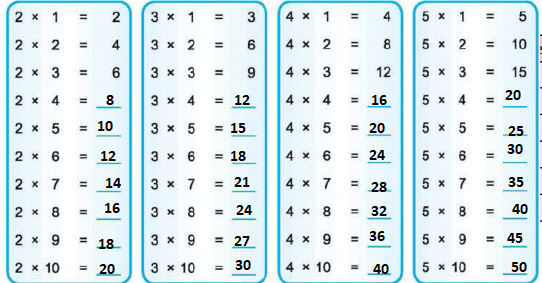Class 3 Maths - Multiplication - CBSE Worksheets Solutions
Question 1: Multiply each of the following:


Question 2: Fill in the blanks:
- 10 x 1 = 10
- 5 x 5 = 25
- 6 x 3 = 18
- 3 x 10 = 30
- 9 x 6 = 54
- 6 x 6 = 30
Question 3: Write the multiplication fact for the repeated addition:
- + 8 + 8 + 8 + 8 + 8 + 8 = 8 x 7
- 5 + 5 + 5 + 5 + 5 + 5 = 5 x 6
- 3 + 3 + 3 + 3 + 3 + 3 = 3 x 6
- 8 + 8 + 8 + 8 + 8 = 8 x 5
- 4 + 4 + 4 = 3 x 4
Question 4: Let us now count the dots and get the table of 9:

Question 5: Let us now count the dots and get the table of 10:

Question 6: Complete the multiplication tables from 2 to 5:

Question 7: Let us now count the dots and get the table of 6:

Question 8: Complete the following multiplication tables:

Question 9: Let us now count the dots and get the table of 7:

Question 10: Let us now count the dots and get the table of 8:

Question 11: Fill in the blanks:
- 5 x 6 = 6 x 5
- 6 x 1 = 6
- 1 x 1 = 1
- 4 x 1 = 4
- 15 x 0 = 0
- 5 x 6 = 6 x 5
- 7 x 0 = 0
Question 12: Find the product using tables:
- 5 x 4 = 20
- 6 x 5 = 30
- 5 x 5 = 25
- 8 x 10 = 80
- 8 x 2 = 16
- 9 x 3 = 27
Question 13: Fill in the blanks:
- 10 x 1 = 10
- 6 x 9 = 54
- 4 x 9 = 36
- 6 x 5 = 30
- 7 x 3 = 21
- 4 x 8 = 32
Question 14: Using the multiplication tables, find the products:


Question 15: Multiply each of the following:


Question 16: Multiply each of the following:


Question 17: Fill in the boxes:

Question 18: Estimate the following sums to the nearest hundreds:
(Also, compare the estimated sums with the actual sums.)
- 375 + 236 = 611
400 + 200 = 600
611 > 600 - 273 + 504 = 777
300 + 500 = 800
800 > 777 - 173 + 58 = 231
200 + 100 = 300
231 < 300 - 287 + 189 = 476
300 + 200 = 400
476 > 400
Question 19: Estimate the following to the nearest hundreds:
(Also, compare the estimated differences with the actual differences.)
- 879 - 705 = 174
900 - 700 = 200
174 < 200 - 613 - 156
613 - 156 = 457
600 - 200 = 400
457 > 400 - 875 - 261 = 614
900 - 300 = 600
614 > 600 - 352 - 256 = 96
400 - 300 = 100
96 < 100
Question 20: Estimate each of the following products by rounding off each number to the nearest tens:
- 41 x 16
40 x 20 = 800 - 37 x 22
40 x 20 = 400
Question 21: A matchbox contains 50 sticks. How many sticks are there in 9 such matchboxes?
1 matchbox contains = 50 sticks
Sticks in 9 matchboxes = 50 x 9 = 450
Question 22: There are 75 toffees in a box. How many toffees will there be in 5 such boxes?
Total number of toffees in a box = 75
Total number of toffees in 5 boxes = 75 x 5 = 375
Question 23: There are 30 days in a month. How many days are there in 6 months?
Total number of days in a month= 30
Total number of days 6 months = 30 x 6 = 180
Question 24: A car can travel 60 km in one hour. How far will it travel in 3 hours?
A car can travel in one hour = 60 km
A car travels in 3 hours = 60 x 3 = 180 km
Question 25: A candle factory produces 55 candles in a day. How many candles will this factory produce in 6 days?
A candle factory produces candles in a day = 55
A candle factory produces candles 6 days = 55 x 6 = 330
|
12 videos|60 docs|25 tests
|
FAQs on Class 3 Maths - Multiplication - CBSE Worksheets Solutions
| 1. How do you multiply two numbers using the standard algorithm? |  |
| 2. What is the significance of the commutative property in multiplication? |  |
| 3. How can multiplication be applied in real-life situations? |  |
| 4. What are some common mistakes students make when multiplying numbers? |  |
| 5. Can you explain the concept of multiplying by multiples of 10? |  |




















